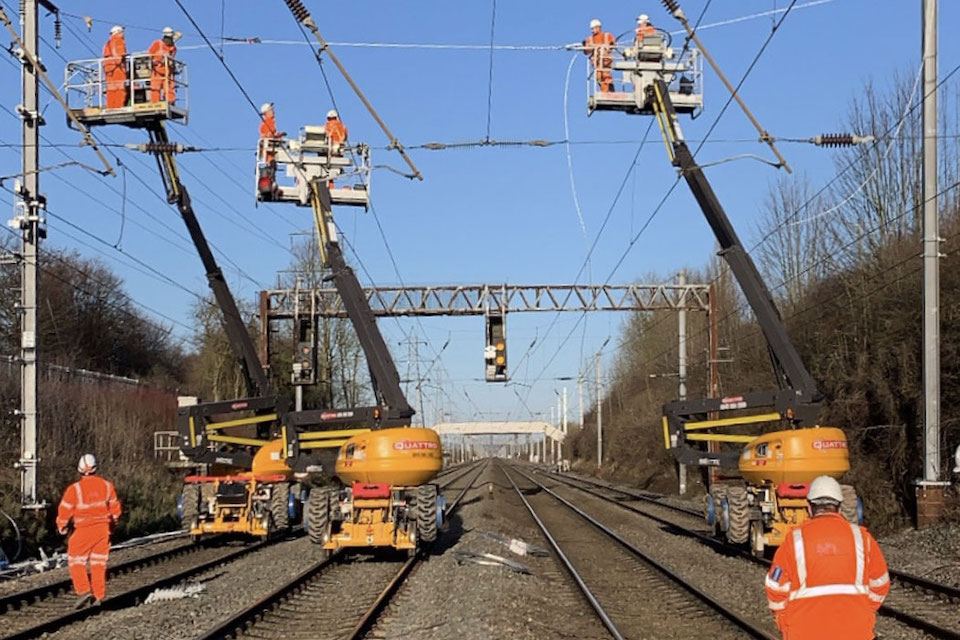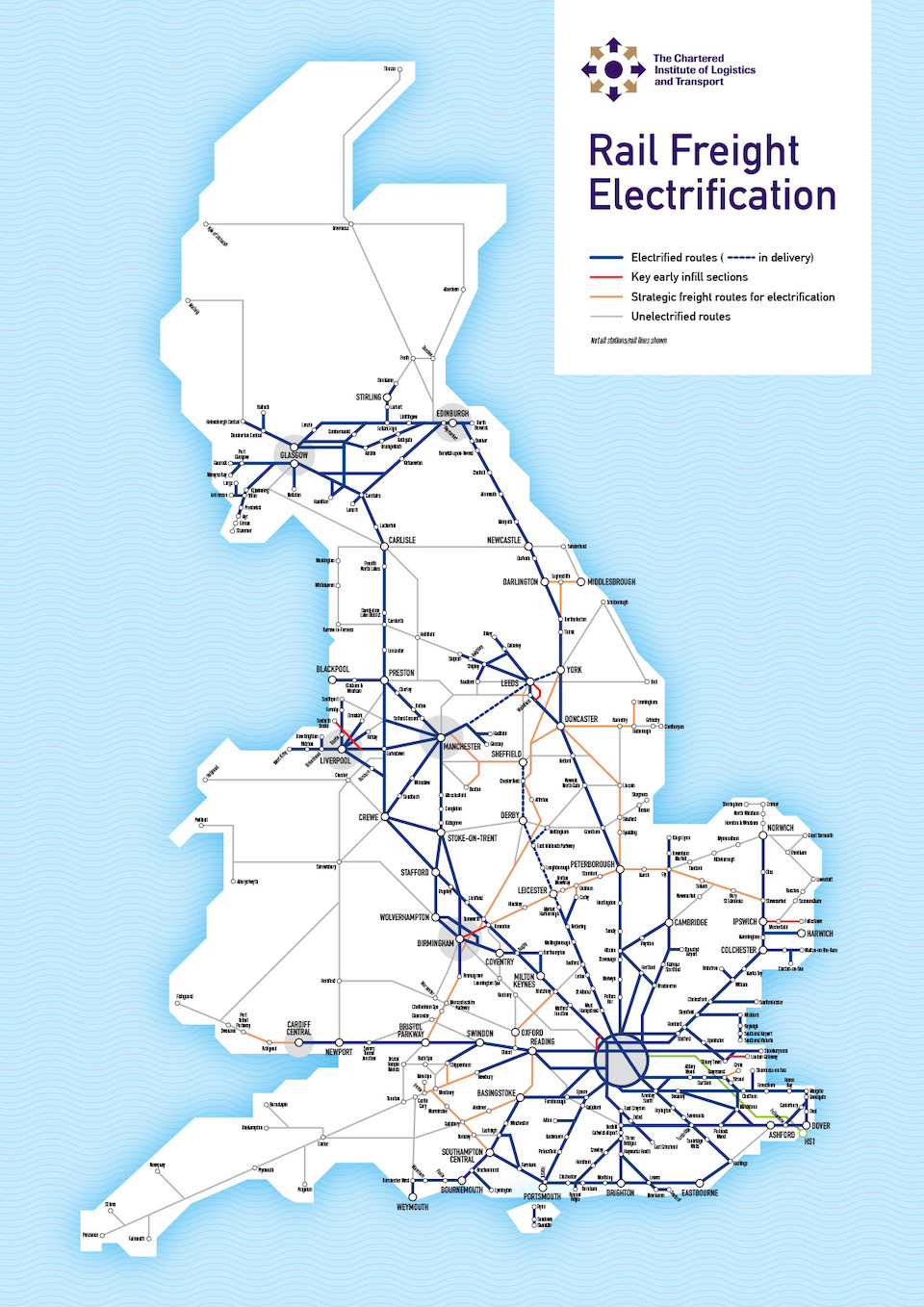Low risk opportunity to electrify almost all UK rail freight

The Chartered Institute of Logistics and Transport says that there is hardly any risk in making a step-change for British rail freight. The professional association says changing the UK from a predominantly diesel-powered rail freight operation to a modern electric network would be a cost effective investment. They say putting Britain into a competitive position would cost no more than a single modest road project and offer far better value for money.
For the bargain basement price of fifty million pounds (around fifty-five million euro) Britain could kickstart a transformation of the rail freight network. That sum would take Britain out of the also-ran category, with currently only ten per cent of rail freight electrically hauled. They say that investment would add around two million zero-carbon train miles every year, which they equate to eighty million road truck miles.
Detailed map and strategy
The statement from the CILT comes hard on the heels of the UK parliamentary transport committee report, Fuelling the Future, which urges the UK government to go ahead and commit to an electrified railway. The Chartered Institute of Logistics and Transport has now released its own electrification strategy research, which reveals the significant opportunity of electrification across the UK’s rail network. Rail electrification is possible for 95 per cent of UK freight trains, CILT research reveals.

CILT has released a detailed map and strategy which demonstrates and details the opportunity in the UK to electrify almost all rail freight operations by the mid-2040s. The research reveals that only 800 miles (1280km) of additional electrification is needed in the UK to enable 95 per cent of rail freight to be electrically hauled. That represents a significant national investment, but, says CILT, the initial 60 miles (96 km) of infill electrification is estimated to cost around fifty million pounds (55 million euro) in each of two years. That they say would be less than the cost of one road scheme – and represent a “no regrets” way of decarbonising key parts of the UK logistics system.
UK lags behind European counterparts
“Currently, a mere 10 per cent of British freight trains are hauled by electric locomotives”, says the CILT report. “The UK lags behind its European counterparts when it comes to rail freight electrification. The Chartered Institute of Logistics and Transport suggests an electrification programme of 40 route miles [64 km] per annum for 20 years, at a cost of one hundred million pounds [120 million euro] per annum, is required to deliver this significant opportunity for the UK to meet its decarbonation and net-zero goals.”
Decarbonising technology for other modes of transport is still emerging, and the CILT say that means there are some challenges still to be overcome. “Electrified rail transport is a fully mature, proven green technology which has been in use for more than 60 years”, they say. “CILT sees this opportunity as ‘low-hanging fruit’ when it comes to decarbonisation and reducing emissions from transport operations.
Three key areas to start the programme
Based on detailed CILT analysis of data on rail freight movements across the UK, the routes proposed for electrification lead from main container ports to inland distribution centres. CILT say they have identified key supply chain hubs, as well as routes from major quarries to urban areas that require large quantities of construction materials. Also included are routes serving other key rail freight customers such as the steel industry.
The research also specifies three priority areas in its electrification strategy:
1. Electrification of the key cross-country route from Felixstowe to the Midlands and North avoiding London, and relieving a number of congested road routes.
2. The next phase would electrify the link from Britain’s third largest container port at Southampton to inland markets.
3. The third phase of the CILT electrification strategy involves routes from major quarries and cement works in the Peak District and the Mendips, feeding into the Midland Main Line, which is currently tabled for electrification.
“The CILT electrification strategy would allow around 95 per cent of UK freight trains to be hauled by electric locomotives by the mid-2040s, saving considerable amounts of carbon every year”, said Julian Worth, the chair of CILT’s Rail Freight Forum and the report’s lead author. “The strategy benefits passengers as well as freight customers. Almost all the routes involved carry passenger trains and the strategy would enable life-expired diesel trains to be replaced by modern electric units”, he said.





Let’s stop wasting time and get on with it, Westminster; follow the Holyrood lead!
Let’s stop wasting time and get on with it, Westminster – follow the Holyrood lead!
As not redundant, thus not robust (but most vulnerable) regrettably current electrification does not meet with market demand and thereby now quality of railway service, rendered clients, seriously is hampered – by current electrification…
(All vital functions of society have to prove redundant!)
Technicalities of infrastructure, optimal when steam was shifted out (100 years ago…) now not even is suboptimal…
(Hybrid electrification, Diesel, or any, urgently is needed!)
Grangemouth Scottish Government electrification is an excellent example of what should be happening throughout UK. Roll on with this proposal year on year.
Absolute joke, there’s the opportunity to run electric locomotives on the WCML, but it’s nearly all diesel powered. Another well known company won a recent contract to move cars north, the same company does not have any electric locomotives. The company that lost out did! All comes down to the cheapest bidder.
Westminster knows what it should do but does not. The same in many areas. Rather like the USA really!
Too many ostriches in charge for far too long. This has been staring us in the face for decades. Anticipate the usual inertia and incompetence.
Electrification, yes, but an optimal, a redundant!
GBRf won the Dagenham to Garston car train contract from DRS . DRS used class 88 electric locomotives on the train.
GBRf is using diesel class 66s but has class 92 electric locomotives that could be used.
It will be the same as usual they will um and ar about it for years and the costs of doing the work will go up and up
Like they always do